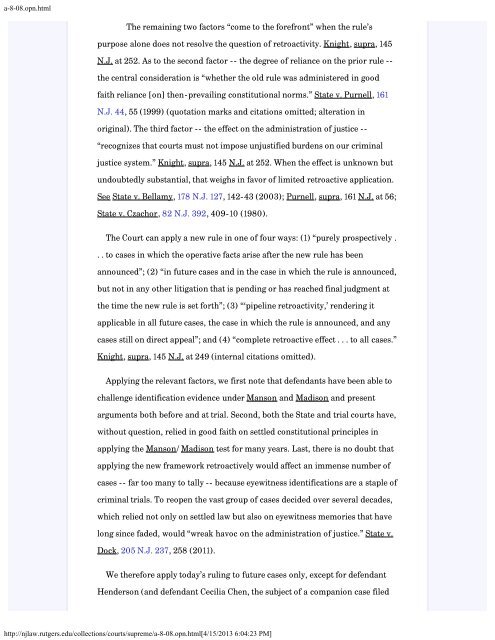State v. Henderson and the New Model Jury Charges - New Jersey ...
State v. Henderson and the New Model Jury Charges - New Jersey ...
State v. Henderson and the New Model Jury Charges - New Jersey ...
You also want an ePaper? Increase the reach of your titles
YUMPU automatically turns print PDFs into web optimized ePapers that Google loves.
a-8-08.opn.html<br />
The remaining two factors “come to <strong>the</strong> forefront” when <strong>the</strong> rule’s<br />
purpose alone does not resolve <strong>the</strong> question of retroactivity. Knight, supra, 145<br />
N.J. at 252. As to <strong>the</strong> second factor -- <strong>the</strong> degree of reliance on <strong>the</strong> prior rule --<br />
<strong>the</strong> central consideration is “whe<strong>the</strong>r <strong>the</strong> old rule was administered in good<br />
faith reliance [on] <strong>the</strong>n-prevailing constitutional norms.” <strong>State</strong> v. Purnell, 161<br />
N.J. 44, 55 (1999) (quotation marks <strong>and</strong> citations omitted; alteration in<br />
original). The third factor -- <strong>the</strong> effect on <strong>the</strong> administration of justice --<br />
“recognizes that courts must not impose unjustified burdens on our criminal<br />
justice system.” Knight, supra, 145 N.J. at 252. When <strong>the</strong> effect is unknown but<br />
undoubtedly substantial, that weighs in favor of limited retroactive application.<br />
See <strong>State</strong> v. Bellamy, 178 N.J. 127, 142-43 (2003); Purnell, supra, 161 N.J. at 56;<br />
<strong>State</strong> v. Czachor, 82 N.J. 392, 409-10 (1980).<br />
The Court can apply a new rule in one of four ways: (1) “purely prospectively .<br />
. . to cases in which <strong>the</strong> operative facts arise after <strong>the</strong> new rule has been<br />
announced”; (2) “in future cases <strong>and</strong> in <strong>the</strong> case in which <strong>the</strong> rule is announced,<br />
but not in any o<strong>the</strong>r litigation that is pending or has reached final judgment at<br />
<strong>the</strong> time <strong>the</strong> new rule is set forth”; (3) “‘pipeline retroactivity,’ rendering it<br />
applicable in all future cases, <strong>the</strong> case in which <strong>the</strong> rule is announced, <strong>and</strong> any<br />
cases still on direct appeal”; <strong>and</strong> (4) “complete retroactive effect . . . to all cases.”<br />
Knight, supra, 145 N.J. at 249 (internal citations omitted).<br />
Applying <strong>the</strong> relevant factors, we first note that defendants have been able to<br />
challenge identification evidence under Manson <strong>and</strong> Madison <strong>and</strong> present<br />
arguments both before <strong>and</strong> at trial. Second, both <strong>the</strong> <strong>State</strong> <strong>and</strong> trial courts have,<br />
without question, relied in good faith on settled constitutional principles in<br />
applying <strong>the</strong> Manson/Madison test for many years. Last, <strong>the</strong>re is no doubt that<br />
applying <strong>the</strong> new framework retroactively would affect an immense number of<br />
cases -- far too many to tally -- because eyewitness identifications are a staple of<br />
criminal trials. To reopen <strong>the</strong> vast group of cases decided over several decades,<br />
which relied not only on settled law but also on eyewitness memories that have<br />
long since faded, would “wreak havoc on <strong>the</strong> administration of justice.” <strong>State</strong> v.<br />
Dock, 205 N.J. 237, 258 (2011).<br />
We <strong>the</strong>refore apply today’s ruling to future cases only, except for defendant<br />
<strong>Henderson</strong> (<strong>and</strong> defendant Cecilia Chen, <strong>the</strong> subject of a companion case filed<br />
http://njlaw.rutgers.edu/collections/courts/supreme/a-8-08.opn.html[4/15/2013 6:04:23 PM]
















